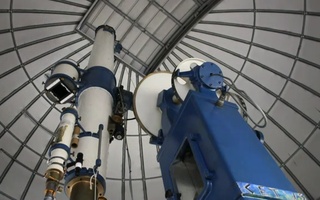After 73 years as Harvard’s eye on the heavens, the telescope at the Oak Ridge Observatory in Harvard, Mass., has reared its head skyward for the final time.
Located 30 miles west of Cambridge, Oak Ridge’s 61-inch-wide Wyeth telescope has a rich history. It was used to discover the first potential planet orbiting a star outside the solar system, and has been used regularly by undergraduates for research. Although it is currently the largest telescope in the country east of Texas, the Oak Hill technology doesn’t measure up to newer models, which have gotten progressively larger and more powerful. Its closure reflects plans to bring the Harvard-Smithsonian Center For Astrophysics’ (CFA) international battery of telescopes up to date.
“As bigger telescopes are being built, smaller ones are being closed,” said Robert Stefanik, the Director of Oak Ridge. “We knew our days were numbered.”
The CFA, which pools the resources of the Harvard and Smithsonian observatories and operated Oak Hill, decided to shut down operations after a report recommended a three-year phase-out two years ago. In June, though, the closure date was abruptly moved up, terminating several projects that were planned.
Multiple astronomers said that light pollution—outside light from nearby cities that limits the visibility of the night sky—was not a factor in the decision to shut down the telescope.
The key determinant, rather, was that Oak Ridge didn’t compare to other CFA sites in Arizona, Chile, and Hawaii, according to Professor of Astronomy and CFA Director Charles Alcock, who made the decision.
Alcock said that despite the fact that CFA’s other telescopes are farther away, astronomers “can collect so much high quality data so quickly that geographic inconveniences are worth overcoming.”
While the closure may seem like a giant leap for those involved, he said, it’s a small step for the CFA itself. The decision did not lie entirely in Harvard’s hands, as it was run by Smithsonian scientists with Smithsonian money.
When first erected, Oak Ridge was the fourth largest telescope in the world, with a mirror five feet in diameter. Today, most telescope mirrors have grown to more than 30 feet in diameter.
However, Senior Lecturer on Astronomy David Latham, who lives across the street from the observatory and has worked there for almost 43 years, said the Oak Ridge telescope was still a valuable asset because its location on a hill in central Massachusetts gets more clear nights than most.
“It gave us better time coverage,” Latham said. “We got a lot of observations at a bargain price.”
Most of the research that was ongoing at Oak Ridge involved gathering data over long periods of time to measure the velocity of stars. Latham said more than half of the measurements in most of his projects have been gathered at Oak Ridge.
Oak Ridge was so precise that in 1988 a team of astronomers, including Latham, used the telescope to observe, for the first time, a wobble in a star’s movement indicative of an orbiting planet. Although other telescopes were pointed at the same stars at the same time, Oak Ridge was the first telescope to detect a wobble.
The Oak Ridge discovery surprised the astrophysics community because few thought that a massive gas giant planet could orbit a star close enough to create visible fluctuations in star velocity. But, since the discovery, about 110 more candidate stars have been found.
Oak Ridge has also been frequented by Harvard undergraduates, since it offers opportunities for both junior and senior thesis research and the lab course Astronomy 191, “Astrophysics Laboratory.”
Read more in News
Bankers Lunch, Laud DiversityRecommended Articles
-
PLANS ARE UNDER WAY FOR MOUNTING NEW TELESCOPEThe new Harvard observatory at Oak Ridge is now carrying on a regular program and preparations are being made to
-
The Other ShuttleScheduling shuttle flights from Boston to Washington, D.C., is easy for many of Harvard's faculty busy in the Clinton administration.
-
Amusements.BOSTON THEATRE.- "The World." GLOBE THEATRE.- "A Dark Secret." BOSTON MUSEUM.- "Little Lord Fauntleroy." HOLLIS ST. THEATRE.- "Daly's Co., in
-
Seitz Launches McKay Lectures Tonight with Metallurgy TalkFrederick Seitz, Jr., director of the training program in nuclear physics at Oak Ridge, Tennessee, will deliver the first in
-
 In a Galaxy Far, Far Away...
In a Galaxy Far, Far Away...













